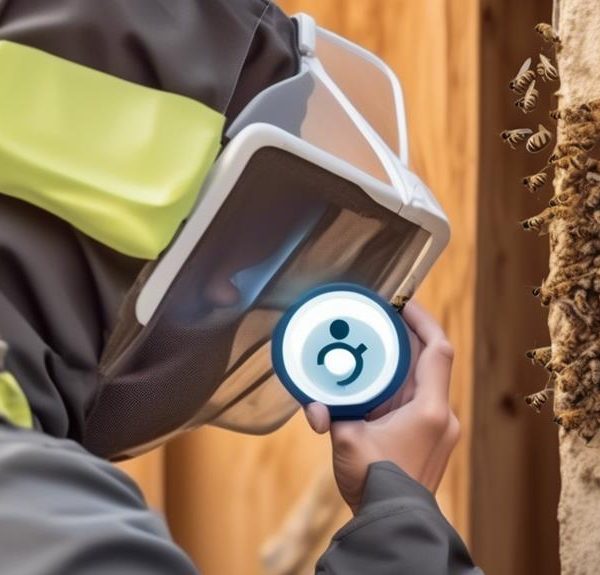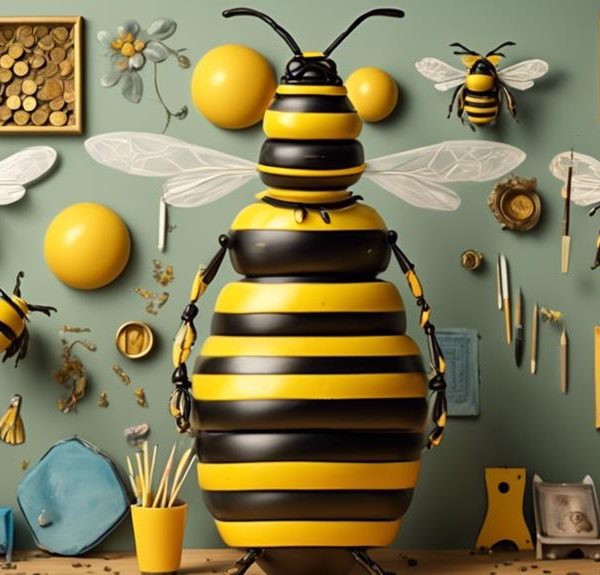Unearth the mystery of black bees, their unique characteristics, and indispensable role in our ecosystem.
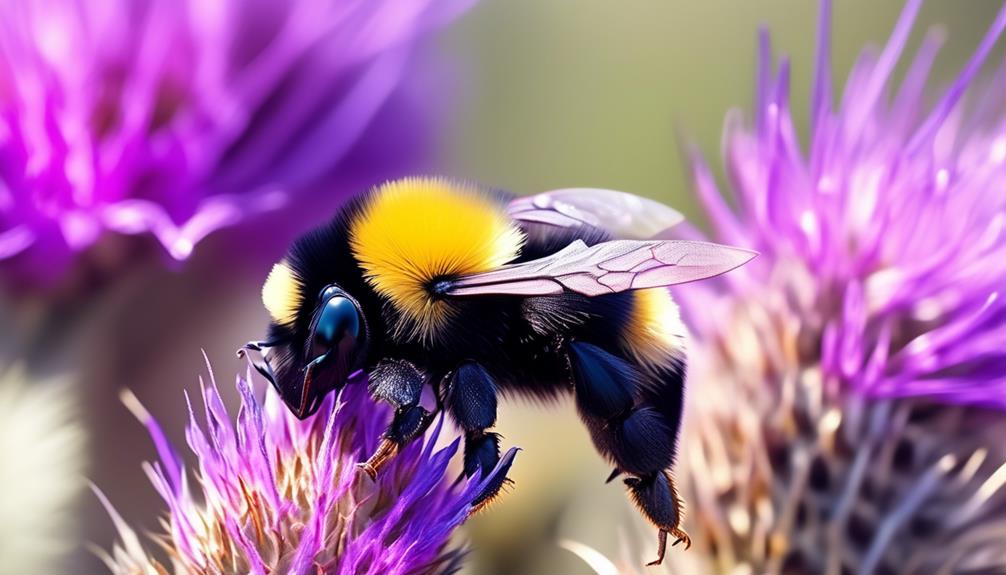
What Bees Are Black?
You might think all bees are yellow and black, but that's not entirely true.
There's a fascinating group of bees, strikingly different in color, known as black bees. Yes, you heard it right. These bees, unlike their more recognized counterparts, don a sleek, glossy black exterior.
As you navigate through the world of these intriguing creatures, you will encounter various types, each with unique characteristics and roles in our ecosystem.
But why should you care about black bees? Stick around, and you'll find out why these little marvels are more important than you might imagine.
Key Takeaways
- Black bees, such as carpenter bees, are larger and lack the distinctive markings of traditional honey bees.
- Black bees, especially carpenter bees, play a vital role in pollinating a wide variety of plants, including those that other bees cannot.
- Black bees contribute to biodiversity by providing habitats for other species in their burrowed nests.
- Conservation efforts, such as habitat restoration and reducing pesticide use, are crucial for the survival of black bees and the preservation of ecosystems.
Identifying Black Bees
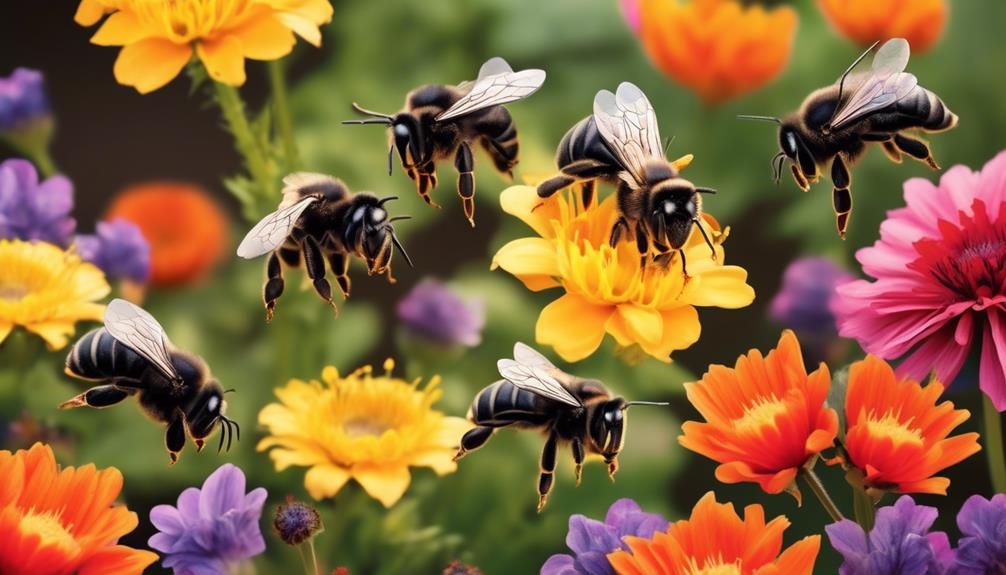
If you're looking to identify black bees, you'll need to observe several distinct features, such as their size, shape, and behavior. Black bees, also known as carpenter bees, are typically larger than their yellow and black counterparts. They can measure up to an inch in size, making them easily distinguishable.
Examine the bee's shape. Black bees have robust, sturdy bodies with a somewhat oblong shape. Their wings are dark and translucent, and they possess large, powerful mandibles for burrowing into wood, which is a distinctive characteristic of their behavior.
Speaking of behavior, black bees are solitary creatures. Unlike honeybees that live in colonies, each black bee tends to live and work alone, only interacting during mating season. They're known for their wood-boring behavior, often burrowing into wooden structures to create nests, which is why they're also called carpenter bees.
Another identifying feature is the shiny, hairless abdomen, which differentiates them from bumblebees that have a hairy abdomen.
Common Types of Black Bees
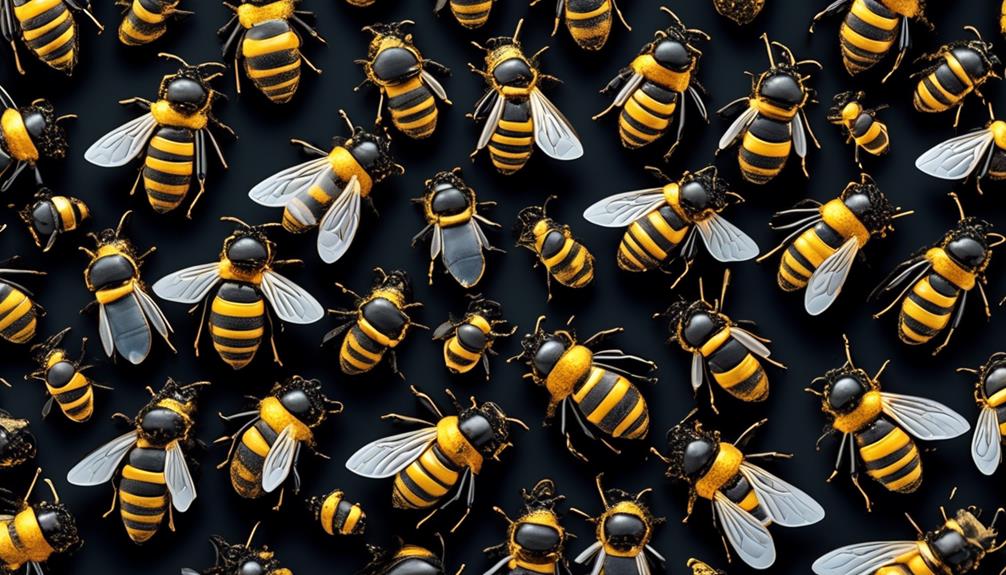
Diving into the world of black bees, you'll find a variety of species, each with unique characteristics and behaviors worth exploring. The Carpenter Bee is one such species, notable for its glossy black body and ability to bore into wood. Unlike most bees, they're solitary creatures, preferring to nest alone.
Then there's the Eastern Carpenter Bee, slightly smaller but similar in appearance to its larger cousin. You'd notice a patch of yellow on their faces, a feature unique to this species. They're known for their tendency to 'rob' nectar by piercing flower bases rather than entering them.
The Mason Bee, another black bee, isn't as flashy. Yet, they're fascinating due to their nesting habits, preferring hollow stems or man-made tubes over typical bee hives. They're excellent pollinators, which makes them valued in any garden.
Finally, there's the Leafcutter Bee. As the name suggests, they cut leaves to line their nests. Like the Mason Bee, they're solitary and remarkable pollinators.
These black bees, while often overlooked, play significant roles in our ecosystems. Recognizing their importance is key to maintaining biodiversity and ensuring a healthy environment.
Black Bees Vs Traditional Bees
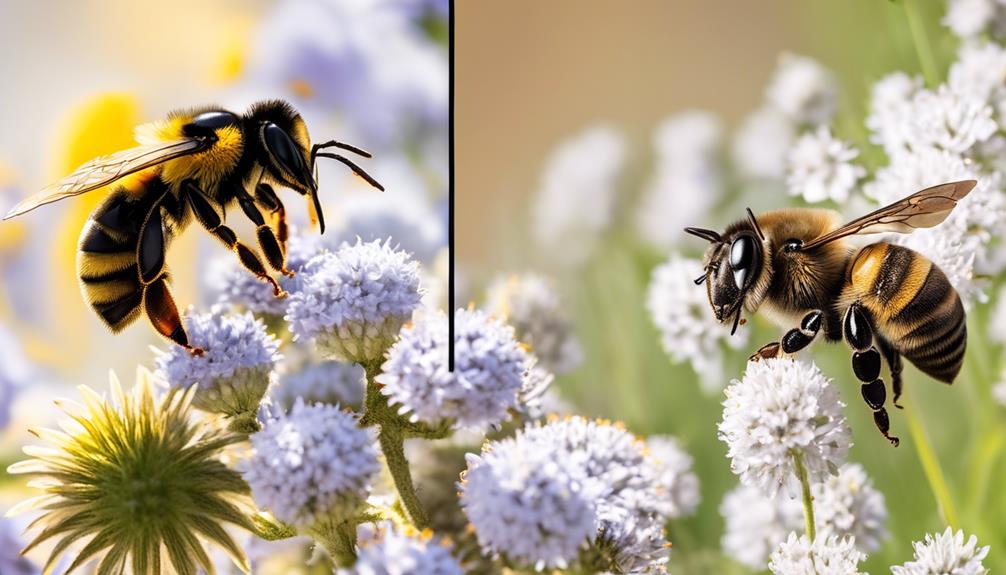
In comparing black bees to traditional bees, you'll notice several distinct differences in their physical characteristics, behaviors, and ecological roles.
Black bees, also known as carpenter bees, are notably larger and feature a shiny, jet-black body. Unlike traditional honey bees, who've stripes, black bees lack these distinctive markings.
Carpenter bees are solitary creatures, preferring to live and mate in individual burrows. This is a stark contrast to honey bees, which thrive in complex, social colonies. Their contrasting social structures impact their pollination habits.
As a solitary bee, the carpenter bee's foraging range is smaller, yet they're more efficient at pollinating a variety of plants within this area. On the other hand, honey bees can cover a larger area but are less efficient, focusing on mass pollination of particular plants.
Lastly, carpenter bees burrow into wood, creating potential damage to structures. Traditional bees, in contrast, build wax combs in hives.
Understanding these differences is crucial for appreciating the diverse roles of bees in our ecosystems. So, while both types of bees are important for pollination, their ecological roles and behaviors can be quite contrasting.
The Role of Black Bees in Nature
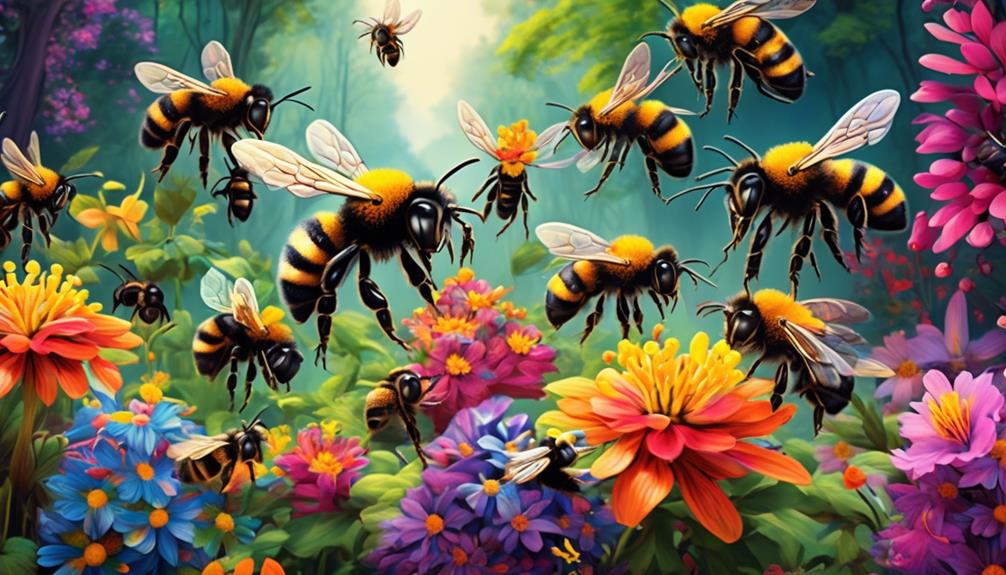
You might be surprised to learn that black bees, or carpenter bees, play a pivotal role in nature despite their solitary lifestyles. These bees aren't just buzzing around aimlessly. They're hard at work, acting as major pollinators.
Their size and strength allow them to pollinate plants that other bees can't, particularly those with deep corollas or tough stamens. They're also known for their 'buzz pollination', which is essential for certain plants like tomatoes and eggplants that rely on this unique method to spread their pollen.
But it's not just about pollination. Black bees also contribute to the biodiversity of the ecosystem. Their nests, often burrowed in wood, provide habitats for other species. They're also a food source to certain predators.
As solitary bees, they don't produce honey or beeswax like their social counterparts, the honey bees. But they're not any less important. The survival of many plant species and the balance of our ecosystems largely depend on them.
Conservation Efforts for Black Bees
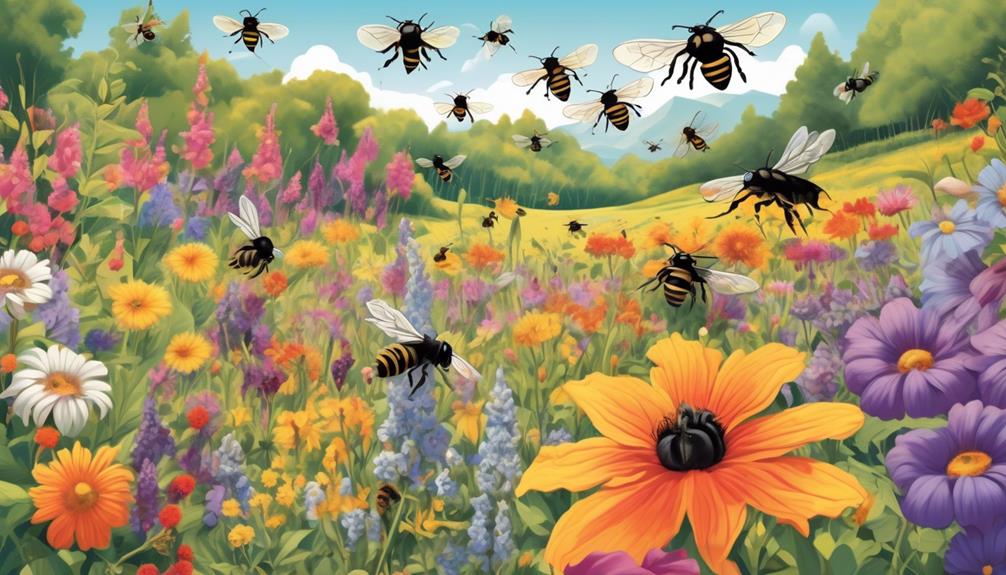
Despite their critical role in ecosystems, black bees face numerous threats, making conservation efforts increasingly important for their survival. You may wonder, what's driving these threats? Habitat loss, pesticides, and climate change all play a part. These factors disrupt the bees' feeding and breeding patterns, leading to population decline.
To counter this, various conservation strategies have been implemented. You can get involved in these efforts too! One approach is habitat restoration. This involves planting native wildflowers and shrubs, which provide essential food sources for the bees. You can do this in your backyard or community gardens.
Another strategy is reducing the use of pesticides. These chemicals are harmful to bees, but you can switch to organic gardening methods to help protect them.
Finally, consider supporting local beekeepers and organizations involved in bee conservation. They're at the forefront of research, education, and advocacy for these vital pollinators.
It's not just about saving the bees; it's about preserving our ecosystems. Every action you take, no matter how small, contributes to the survival of black bees. So, let's do our part to ensure these hardworking creatures continue to thrive.
Frequently Asked Questions
How Does the Lifespan of Black Bees Compare to Other Bee Species?
You're curious about the lifespan of black bees compared to other species. Well, it varies.
Carpenter bees, which are often black, can live up to 3 years.
Honeybees, in contrast, live only a few weeks to 6 months.
Bumblebees also have a shorter lifespan, usually one season.
So, black bees like the Carpenter bee generally have a longer lifespan than many other bee species.
However, lifespan greatly depends on the individual species and their specific environmental conditions.
What Are the Predators of Black Bees?
You're curious about the predators of black bees, aren't you? Several creatures pose a threat to these bees.
Birds, spiders, wasps, and even humans can be considered predators. Some mammals, like bears and badgers, are known to destroy their hives in search of honey and larvae.
Additionally, certain parasites and diseases can also significantly impact their population.
It's a tough world for these little pollinators, isn't it?
Are Black Bees More or Less Aggressive Than Other Bee Species?
You're wondering if black bees are more or less aggressive than other bee species.
Generally, the color of a bee doesn't determine its aggression. Instead, it depends on the species and the circumstances.
Some black bees, like carpenter bees, are quite docile unless provoked. Others, like certain species of bumblebees, can be more defensive.
Keep in mind, it's always best to avoid disturbing any bees, regardless of color.
Do Black Bees Produce Honey and if So, Does It Differ From Traditional Honey?
Yes, you'll find that black bees, specifically the Carpenter and Bumblebee species, do produce honey. However, it's not in quantities significant enough for commercial harvesting.
As for the taste, it doesn't vastly differ from traditional honey. It's important to note, honey's flavor can vary based on the type of flowers the bees have been foraging on, not necessarily the species of the bee.
Can Black Bees Be Found Worldwide or Are They Native to Certain Regions?
You can find black bees, particularly the Carpenter Bee, worldwide, but they're more common in certain regions. For instance, they're native to North America, Asia, and South Africa. However, their presence isn't exclusive to these areas.
You might spot them in other regions too, due to their adaptability to various climates and environments. So, wherever you are, keep an eye out for these fascinating creatures!
Conclusion
In conclusion, you've learned black bees range from common types like Carpenter bees to rarer species like Mason bees.
They may not resemble traditional bees, but they play a vital role in nature, pollinating plants that other bees can't. Their survival is critical, hence the need for conservation efforts.
Understanding and appreciating these black bees is key to preserving biodiversity and ensuring the health of our ecosystems.

